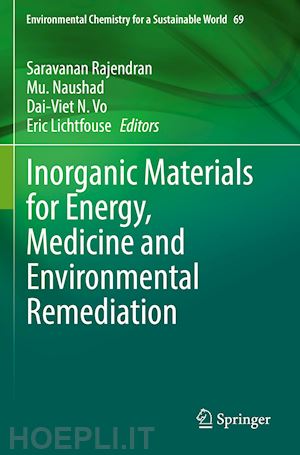
Questo prodotto usufruisce delle SPEDIZIONI GRATIS
selezionando l'opzione Corriere Veloce in fase di ordine.
Pagabile anche con Carta della cultura giovani e del merito, 18App Bonus Cultura e Carta del Docente
Chapter 1
Localized surface plasmon resonance in colloidal copper sulphide (Cu2-xS, x=0=x<1) nanocrystals and its applications
Ananthakumar Soosaimanickam, Tamilselvan Sakthivel, Balaji Sambandam, Samuel Paul David and Anandhi Sivaramalingam
Chapter 2
Titanium dioxide/graphene nanocomposites as high-performance anode material for lithium ion batteries
Leya Rose Raphael, Krishnan M. A, Jarin D. Joyner, Akhila Das, Neethu T. M Balakrishnan, Jou-Hyeon Ahn, Jabeen Fatima M. J, and Raghavan Prasanth
Chapter 3
Design and fabrication of nano-structured materials for fuel cell application
Wahid Ali, Mohammad Ehtisham Khan, and Akbar Mohammad
Chapter 4
Synthesis of nano-particles and its applications in heavy metal removal from wastewater
V. Yogeshwaran, and A.K. Priya
Chapter 5
Role of Metal and Metal Oxides for the removal of water pollutants
J. Santhosh Kumar, Rosalin Beura and P. Thangadurai
Chapter 6
Magnetic Nanomaterials for Energy Storage Applications
Thirumurugan Arun, Shanmuga Sundar Dhanabalan, Rednam Udaya Bhaskar, K. Ravichandran, Ali Akbari-Fakhrabadi, and Mauricio J. Morel
Chapter 7
Emerging nano-structured metal oxides for detoxification of organic pollutants towards environmental remediation: Overview and future aspects
S. Nagarajan, J.Nimita Jebaranjitham, B.Ganesh Kumar, and Devaraj Manoj
Chapter 8
Metal nanostructures derived composites for catalytic conversion of organic contaminants in wastewater
Somasundaram Saravanamoorthy, Muniyandi Muneeswaran, Vanaraj Ramkumar, Andivelu Ilangovan and Mayakrishnan Gopiraman
Chapter 9
Removal of persistent organic pollutants using redox active metal oxide nanocatalysts via advanced oxidation process
Kumar Kashyap Hazarika, Chiranjita Goswami and Pankaj Bharali
Chapter 10
Metal-based particles as a catalyst for Proton exchange membrane fuel cells
Mohammad Javadi, Hassan Karimi-Maleh, and Nobanathi Wendy MaxakatoDr. Mu. Naushad is presently working as a Full Professor in the Department of Chemistry, College of Science, King Saud University (KSU), Riyadh, Kingdom of Saudi Arabia. He is also Distinguished Researcher at Yonsei Frontier Lab, Yonsei University, Seoul, Korea. He obtained his M.Sc. and Ph.D. Degree in Analytical Chemistry from Aligarh Muslim University, Aligarh, India in 2002 and 2007, respectively. He has vast research experience in the multidisciplinary fields of Analytical Chemistry, Materials Chemistry and Environmental Science. He holds several US patents, over 350 publications in the international Journals of repute, twenty-five book chapters and several books published by renowned international publishers. He has >17500 citations with a Google Scholar H-Index of >70. He has been included in the list of Highly Cited Researchers in 2019 & 2020. He has successfully run several research projects funded by the National plan for Science and Technology (NPST) and King Abdulaziz City for Science and Technology (KACST), Kingdom of Saudi Arabia. He is the editor/editorial member of several reputed Journals like Scientific Report (Nature); Journal of Water Process Engineering (Elsevier) and International Journal of Environmental Research & Public Health (MDPI); Polymers (MDPI), Current Pollution Reports (Springer). He is also the associate editor for Environmental Chemistry Letters (Springer) and Desalination & Water Treatment (Taylor & Francis). He has been awarded the Scientist of the year award-2015 from National Environmental Science Academy, Delhi, India and Almarai Award-2017, Saudi Arabia and Best Research Quality award-2019, King Saud University, Saudi Arabia.
Dr. Dai-Viet N. Vo received his Ph.D. degree in Chemical Engineering from The University of New South Wales in Sydney, Australia in 2011. He has worked as a postdoctoral fellow at the University of New South Wales in Sydney and Texas A&M University at Qatar, Doha. He has been appointed as a Senior Lecturer at the Faculty of Chemical & Natural Resources Engineering, Universiti Malaysia Pahang in Kuantan, Malaysia from June 2013 to June 2019. Dr. Vo is currently the Director of the Center of Excellence for Green Energy and Environmental Nanomaterials at Nguyen Tat Thanh University in Ho Chi Minh City, Vietnam. His research areas are the production of green synthetic fuels via Fischer-Tropsch synthesis using biomass-derived syngas from reforming processes. He is also an expert in advanced material synthesis and catalyst characterization. During his early career, he has worked as the principal investigator and co-investigator for 23 different funded research projects related to sustainable and alternative energy. He has published 2 books, 16 book chapters, more than 185 peer-reviewed journals including 38 prestigious review articles and more than 80 conference proceedings.











Il sito utilizza cookie ed altri strumenti di tracciamento che raccolgono informazioni dal dispositivo dell’utente. Oltre ai cookie tecnici ed analitici aggregati, strettamente necessari per il funzionamento di questo sito web, previo consenso dell’utente possono essere installati cookie di profilazione e marketing e cookie dei social media. Cliccando su “Accetto tutti i cookie” saranno attivate tutte le categorie di cookie. Per accettare solo deterninate categorie di cookie, cliccare invece su “Impostazioni cookie”. Chiudendo il banner o continuando a navigare saranno installati solo cookie tecnici. Per maggiori dettagli, consultare la Cookie Policy.